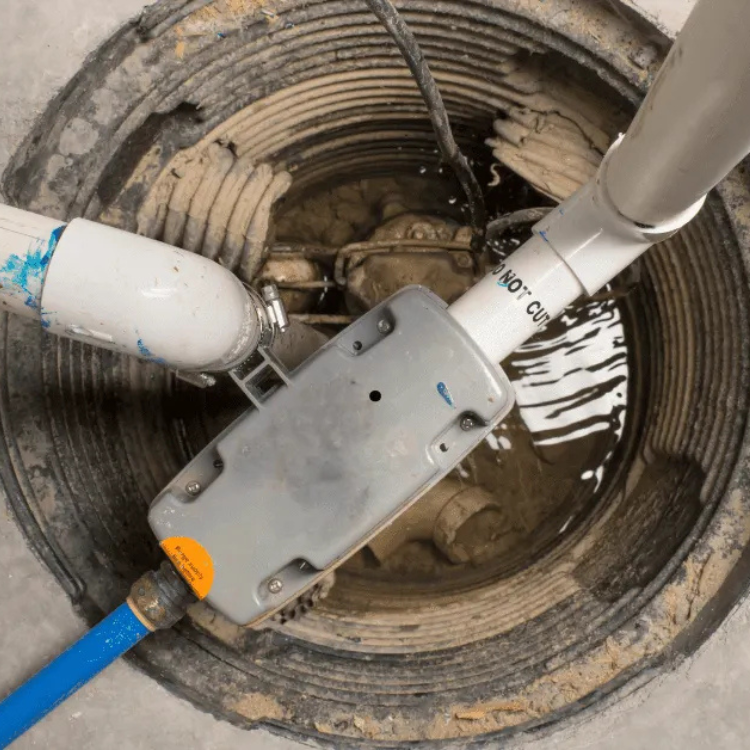
If you have a sump pump in your Central Ohio home, chances are it’s quietly working behind the scenes to protect your basement from flooding. But like any part of your plumbing system, your sump pump maintenance routine needs consistent attention to keep it your pump running smoothly. One of the most overlooked (but critical) tasks is cleaning the sump pump pit itself.
 Neglecting to clean the sump pump pit can result in a variety of issues that compromise the efficiency and reliability of your plumbing system. Over time, debris such as dirt, sand, and other particles can accumulate in the pit, leading to clogged pumps that struggle to function properly. This can cause unpleasant odors to emanate from the basement, as stagnant water and decaying organic matter create a breeding ground for mold and bacteria.
Neglecting to clean the sump pump pit can result in a variety of issues that compromise the efficiency and reliability of your plumbing system. Over time, debris such as dirt, sand, and other particles can accumulate in the pit, leading to clogged pumps that struggle to function properly. This can cause unpleasant odors to emanate from the basement, as stagnant water and decaying organic matter create a breeding ground for mold and bacteria.
More critically, the buildup of debris can lead to complete system failure, leaving your home vulnerable to flooding during periods of heavy rain or rapid snowmelt. This is precisely when you rely on your sump pump the most to protect your basement from water damage, making regular maintenance and cleaning of the pit an essential task for homeowners.
Why Cleaning the Sump Pump Pit Is So Important
The sump pit is where all the water collects before the pump activates and moves it out of your home. Over time, dirt, sand, debris, and even mold can accumulate in the pit. If that debris makes its way into the pump mechanism, it can block the impeller, overwork the motor, or jam the float switch. That’s a recipe for a plumbing emergency and potential water damage.
We recently helped a homeowner in Gahanna who called us after their sump pump failed during a storm. The culprit? A clogged pit full of mud and gravel. Their pump couldn’t activate, and they ended up with 2 inches of water across the basement floor. Cleaning the pit could have prevented the mess—and the expensive repairs.
Signs It’s Time to Clean Your Sump Pump Pit
Routine cleaning should be done at least once a year, ideally in spring or fall. But if you notice any of the following signs, it’s time to act sooner:
- Unusual noises like grinding or buzzing from the pump while it runs may indicate debris is interfering with the impeller or motor.
- Foul odors coming from the basement or sump area are often caused by stagnant water, mold, or rotting debris inside the pit.
- Frequent cycling (turning on and off) could be caused by a float switch getting stuck due to gunk in the pit.
- Slow draining water or water standing in the pit longer than usual suggests blockages are preventing proper flow.
 How to Clean a Sump Pump Pit the Right Way
How to Clean a Sump Pump Pit the Right Way
Cleaning your sump pit doesn’t have to be complicated, but it does require care and the right tools. If you're up for the task, here's what to expect:
- Turn off the power and unplug the pump: Always prioritize safety. If you have a battery backup system, disable that, too.
- Remove the pump: Carefully lift it out of the pit and place it in a sturdy container or bucket to catch any remaining water or debris.
- Clear out the pit: Scoop out dirt, sediment, and standing water using a shop vac or hand tools. Be sure to remove any rocks, twigs, or other large debris.
- Clean the pump: Use a hose and a soft brush to rinse the pump and remove any buildup from the exterior and intake screen.
- Check the float and discharge line: Make sure the float moves freely and that the discharge line isn’t clogged.
- Reassemble and test: Place the pump back into the pit, plug it in, and pour water into the pit to confirm it activates properly.
If this sounds like more than you want to handle—or you’re not sure your pump is working as it should—it’s a good idea to call a professional.
Why a Pro May Be the Best Choice
Professional plumbers not only clean the sump pit, they also check the entire system for wear, electrical problems, and signs of failure. At Crawford Mechanical Services, we often find issues during routine sump pump system checks that homeowners didn’t realize were developing—like a failing motor or a backup battery that no longer holds a charge.
A quick inspection from an expert can give you confidence your system is ready for the next storm, and it’s especially helpful if your sump pump is more than five years old.
Don’t Wait for a Backup to Clean the Pit
 Cleaning your sump pump pit is one of the simplest ways to extend the life of your sump pump and avoid costly basement water damage. If it’s been over a year since your last cleaning—or if you’re unsure where to start—let our experienced team at Crawford Mechanical Services help.
Cleaning your sump pump pit is one of the simplest ways to extend the life of your sump pump and avoid costly basement water damage. If it’s been over a year since your last cleaning—or if you’re unsure where to start—let our experienced team at Crawford Mechanical Services help.
At Crawford Mechanical Services, we proudly serve homeowners throughout Columbus, Dublin, Westerville, and surrounding areas with sump pump cleaning, repair, and replacement services. Schedule your sump pump system check today and make sure your basement stays dry all year long.




